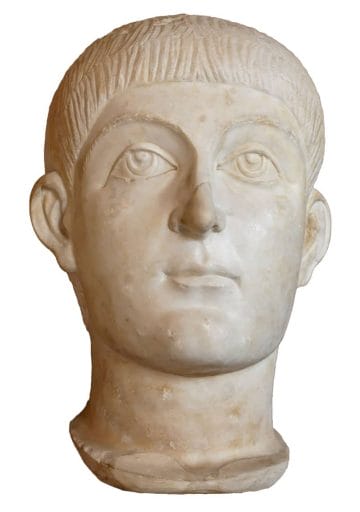Last Updated on December 25, 2021 by Vladimir Vulic
Life: AD c. 328 – 378

- Name: Flavius Julius Valens
- Born in AD ca. 328 at Cibalae, Pannonia.
- Became emperor early in AD 364.
- Wife; Albia Domnica (three children).
- Died near Hadrianopolis, 9 August AD 378.
Valens was born around AD 328, as the second son of a native of Cibalae in Pannonia called Gratianus.
Alike his brother Valentinian he made a military career. He eventually came serve under Julian and Jovian in the household guard.
When Valentinian became ruler in AD 364, Valens was chosen to rule alongside his brother as co-Augustus.
While Valentinian chose the less prosperous and more endangered west, he appeared to leave the easier part of the rule to his brother in the east.
Had there been previous divisions of the empire into eastern and western parts, then it had always been eventually unified again. This division though between Valentinian and Valens proved to be final. For a short time the empires should run in harmony. And indeed under Theododius they would even be briefly reunited again. Though it was this division which is seen as the defining moment when east and west established themselves as separate realms.
However much easier the task in the east seemed at first, serious problems soon arose. Was Valens married to Albia Domnica then her father was Petronius, a man widely despised in Constantinople for his greed, cruelty and ruthlessness. So deep seated was the loathing that in AD 365 it even came to a revolt against the emperor and his hated father-in-law.
It was a retired military commander named Procopius who led the revolt and who was even hailed emperor and enjoyed widespread support.
In AD 366 the forces of Procopius and Valens met at Nacolea in Phrygia. Procopius was betrayed by his generals who deserted him and once he fled he was betrayed yet again and executed.
His position as emperor of the east alas secured, Valens now turned to the threats facing his empire from the north. For the Visigoths, who had already lent Procopius their assistance, were becoming an ever greater threat to the Danubian provinces. Valens countered this threat by crossing the Danube with his troops and devastating much of their territory in AD 367 and then in AD 369 once more.
Thereafter Valens was occupied by troubles arising in the east. Among other things was a conspiracy surrounding a certain Theodorus, which needed to be dealt with in Antioch during AD 371/2.
In AD 375, at the death of his brother Valentinian, Valens assumed the rank of senior Augustus over his nephew Gratian in the west.
Valens was not to show the religious tolerance of his brother in the west. He was a vehement follower of the Arian branch of Christianity and actively persecuted the Catholic church. Some bishops were banished other members of the church met their death.
Next Valens attacked the Persians, though despite achieving one victory in Mesopotamia, hostilities soon ended in another peace treaty in AD 376, neither of the two sides being able to make much of an impression on the other by force of arms.
But then events begun unfolding which should lead to disaster. In the same year as the peace treaty with the Persians, AD 376, the Visigoths came flooding across the Danube in unbelievable numbers.
The cause of this unprecedented invasion was the arrival of the Huns hundreds of miles to the east. The realms of the Ostrogoths (the ‘bright Goths’) and the Visigoths (the ‘wise’ Goths) were being smashed by the arrival of the notorious horsemen, pushing a first wave of terrified Visigothic refugees across the Danube.
What followed was a disaster from which the Roman empire would never recover. Valens permitted the Visigoths to settle in the Danubian provinces in their hundreds of thousands.
This introduced a barbarian nation into the territory of the empire. Had the Danube provided a protective bulwark against the barbarians for centuries, then now the barbarians suddenly were within.
More so, the new settlers were treated deplorably by their Roman governors. They were desperately exploited and forced to live in cramped starvation conditions. It was no wonder that they rebelled. With no frontier troops to stop them crossing into roman territory, the Visigoths, under their leader Fritigern, could now ravage the Balkans with ease.
And to make matters worse, the mayhem created by the Visigoths caused such large-scale disruption that hordes of further German tribes could pour across the Danube behind them.
Valens rushed back from Asia to deal with this terrible crisis. He called upon Gratian to come to his support, yet the western emperor had trouble of his own dealing with the Alemanni. Though once Gratian had freed himself from the immediate menace of the Alemanni, he sent word to Valens that he was coming to his aid and he indeed did mobilize a force and begin marching east.
But Valens decided to move without he help of his co-emperor. Perhaps he was overconfident, his general Sebastianus already having fought a successful engagement at Beroe Augusta Trajana in Thrace against the enemy. Perhaps the situation became impossible and he saw himself forced to act. Perhaps he simply did not want to share the glory with his nephew Gratian. Whatever Valens’ reasons, he acted alone and engaged a massive Gothic force of an estimated 200’000 warriors near Hadrianopolis (also Hadrianople and Adrianople). The result was a catastrophe. Valens army was completely annihilated.
Valens himself perished in the Battle of Adrianople (9 August AD 378). His body was never found.

Historian Franco Cavazzi dedicated hundreds of hours of his life to creating this website, roman-empire.net as a trove of educational material on this fascinating period of history. His work has been cited in a number of textbooks on the Roman Empire and mentioned on numerous publications such as the New York Times, PBS, The Guardian, and many more.
